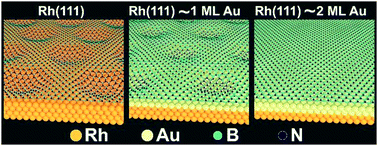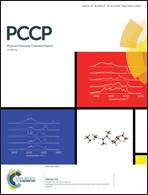Tailoring the hexagonal boron nitride nanomesh on Rh(111) with gold
Abstract
It is known that the hexagonal boron nitride (h-BN) monolayer has a periodically corrugated structure on Rh(111), termed “nanomesh”, while the h-BN layer is planar on the close packed surfaces of coinage metals (Cu, Ag, Au) due the weak interactions. Our studies are aimed at understanding the metal–h-BN interaction, when both Rh and Au are present. On the one hand, the growth and thermal properties of gold deposited on h-BN nanomesh prepared on Rh(111) were studied. On the other hand, the formation of h-BN was examined on Au/Rh surface alloys prepared by the deposition of Au on Rh(111) and subsequent annealing at 1000 K. In each case, the h-BN was prepared by the decomposition of borazine at about 1000 K. Low energy ion scattering (LEIS), X-ray photoelectron spectroscopy (XPS) and scanning tunneling microscopy (STM) measurements revealed that the growth of Au on h-BN/Rh(111) at room temperature leads to the formation of mainly three dimensional (3D) gold nanoparticles, although at low coverages (<0.2 ML) 2D particles formed as well. Stepwise annealing to higher temperatures induces the intercalation of Au below the nanomesh, which was complete at around 1050 K. Some agglomeration and desorption of Au also took place. Interestingly, the nanomesh structure was observable after intercalation up to relatively large Au coverages. Measurements performed in the reverse order, namely exposing a Au/Rh(111) surface alloy to borazine, revealed that Rh atoms get covered by h-BN (or by its precursors) at significantly smaller borazine exposures than Au atoms. The nanomesh structure was essentially present up to a gold coverage of 0.9 ML, but with a smaller pore diameter, while it gradually disappeared at higher gold amounts. In this way the application of surface alloy supports provides a key for gradual tuning of the mesh morphology. Density functional theory calculations confirmed the decreased pore diameter of the BN layer upon the formation of a surface Rh–Au alloy layer.



 Please wait while we load your content...
Please wait while we load your content...